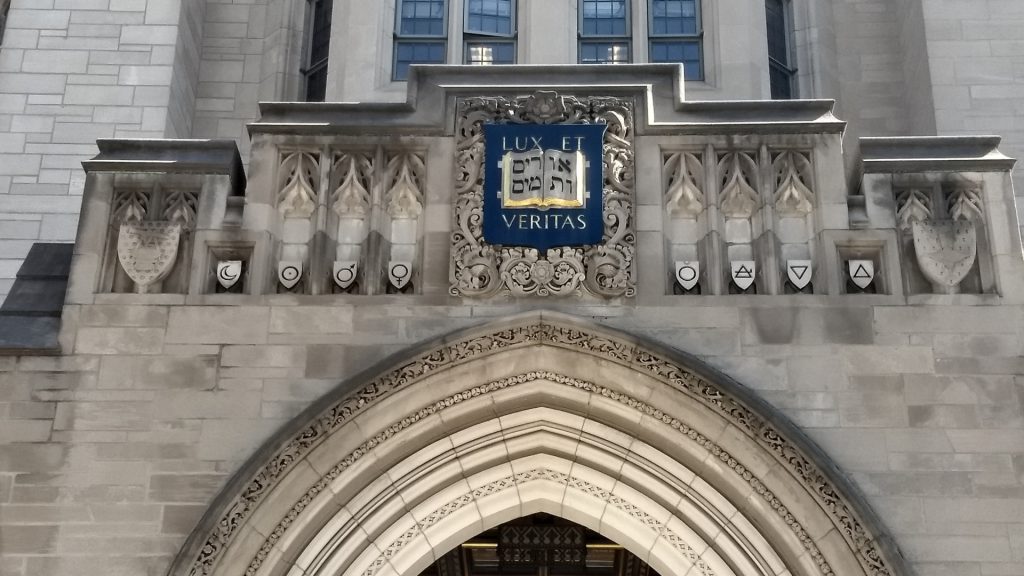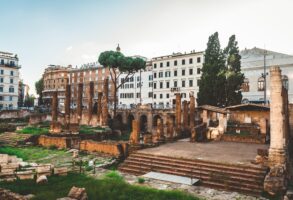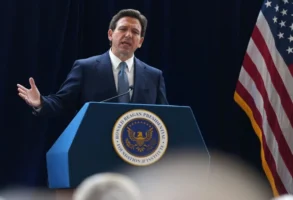
Published January 27, 2020
The opening chapter of the book that launched the modern conservative movement was about God. That is, the first chapter of William F. Buckley’s 1951 book, God and Man at Yale, was about the modern university’s subversion of faith in God. The conservative movement thus arose out of a dispute in the halls of the academy over the nature of ultimate things. This pattern continues to hold.
It has recently been argued that the sharp decline in the popularity of the humanities on campus is the result of a “second secularization,” a collapse of our regard for high culture that parallels and reflects the broader decline of religious faith. The second secularization is not new, however. It entered public consciousness with the modern campus culture wars, the opening shot of which from the conservative side was the publication of Allan Bloom’s 1987 book, The Closing of the American Mind. The 1987–88 dispute over the teaching of Western Civilization at Stanford swiftly followed, as did books like Roger Kimball’s Tenured Radicals (1990) and Dinesh D’Souza’s Illiberal Education (1991).
The “ultimate things” in dispute in the second secularization are the goodness, continuity, and even the very reality of Western Civilization, and of America’s place within it. From the left side, the second secularization began with works like Stanley Fish’s 1980, Is There a Text in This Class? There Fish challenged our faith in the very existence of objectivity, reality, and truth. In the wake of declining belief in God, faith in almost any anchor outside ourselves had dimmed.
We can think of politics today as the effect of continuing conservative pushback against both the first and second secularizations. Just as it has taken more than three decades for campus humanities departments to commit enrollment suicide by destroying faith in Western Civilization, the Great Books, objectivity, and reality itself, so it has taken several decades for the specifically political consequences of the second secularization to emerge.
What began as a fascinating cultural sideshow has become our politics. The dispute between campus multiculturalism and traditional American conceptions of citizenship launched at Stanford in 1987 is now the everyday stuff of our debates. Controversies over race, gender, and ethnicity are ubiquitous. The ideal of global citizenship contends with faith in America and the West. Even the core Western commitment to freedom of speech is challenged now by intersectional orthodoxy. All of this was in play at Stanford in the late 1980s. It has taken three decades, but today who we vote for has everything to do with how we see these disputes.
Is the “Great Awokening” really part of a quasi-religious argument over “ultimate things?” Cancel culture seems awfully distant from Stanley Fish’s philosophical challenge to objectivity, reality, and truth. (In fact, Stanley Fish himself was “canceled” recently.) Yet the postmodern challenge to objective reality is also a claim that so-called neutrality and truth are cloaks for the interests of the powerful. The systematic skepticism of Fish, Foucault, and their postmodernist colleagues is a technique for repudiating classical liberalism in the name of the new gods: race, class, gender, ethnicity, and such. The twitterati absorb these postmodernist debunking techniques in college, and now from the cultural air itself. Whereas the politics of “woke” may seem the opposite of skeptical relativism, in fact it flows from unbelief. The Great Awokening is a product of the second secularization.
In the matter of the first secularization, Buckley could not have been more correct. So complete has been the collapse of religion at our universities that it’s tough to even imagine a national controversy over the place of faith in elite college classrooms. Yet in 1951, Yale denied everything. Working with a thinned-out definition of religion, Yale’s grandees may even have believed those denials.
Buckley is rightly credited with almost single-handedly shattering America’s liberal consensus. From another perspective, however, he simply recognized that the liberal consensus was unraveling on its own. Buckley’s argument had teeth because he could invoke a paean to the place of Christianity at Yale from President Charles Seymour’s Inaugural Address of 1937. Seven years before Buckley wrote, President Roosevelt had led the nation in a prayer to “Almighty God” on the eve of the D-Day invasion. That prayer would startle coming from a Democratic president today. Once America’s liberal consensus expelled religion, that consensus was no more. Thus was modern conservatism born.
This was the most controversial passage from God and Man at Yale:
I believe that the duel between Christianity and atheism is the most important in the world. I further believe that the struggle between individualism and collectivism is the same struggle reproduced on another level.
Buckley links the central political battle of his day with a cultural struggle over ultimate things. Politics is culture “on another level.”
Buckley faced challenges that conservatives concerned with culture still confront. He complained of conservatives so averse to cultural controversy that they hesitate to take even their own side in a public battle. He insisted that the immense cultural and political significance of education was being slighted by a single-minded focus on communism.
One of Buckley’s targets offered a preview of what was to come. Looking beyond Yale, Buckley had gone after Harvard’s influential 1945 report on General Education in a Free Society (aka the “Redbook”) on grounds that it short-shrifted the place of religion in the curriculum. Instead, Harvard’s Redbook elevated and reinforced the already-existing trend toward the teaching of Western Civilization as a foundation for democratic citizenship.
Buckley was all for the teaching of Western Civilization. His point was that the lesson would not take hold in the absence of religious faith. Yet the Redbook set religion aside, looking instead to sustain a free society through a secular course on the great themes of the Western heritage: representative government, rule of law, the philosophy of natural rights, the power of reason, free markets, etc. Within a few decades, however, even the glories of Western Civilization were under attack. The second secularization was in motion.
The process began in earnest in the 1960s. Western Civilization courses were swept away, along with most other requirements, by students who rejected such constraint. The faculty was reluctant to make the case for the requirement, in part because it was losing its own faith in the West. At Stanford and some other schools, Western Civ had returned by the 1980s, setting up the next great battle. By then, Sixties radicals had joined the faculty, helping to kick-start identity politics on campus. Now Western Civilization would fall under attack on overtly ideological grounds. American multiculturalism was about to be born.
Just before the Stanford dustup of 1987–88, Allan Bloom literally picked up where Buckley had left off. Waiting until the very last paragraph of his survey of Yale’s antireligious curriculum, Buckley finally mentioned “the substantial contribution to secularism that is being made at Yale and elsewhere by widespread academic reliance on relativism . . .” Bloom, for his part, eschewed Buckley’s concern for religion and began instead with the following sentence, “There is one thing a professor can be absolutely certain of: almost every student entering the university believes, or says he believes, that truth is relative.” Bloom worried that abandonment of the search for truth would bring neglect of the Great Books and the fundamental life-choices they made possible. His target was the second secularization, not the first.
The nascent multiculturalist left at Stanford quite consciously viewed their attack on the Great Books as a form of secularization. The radicals charged campus traditionalists with treating the canon as a collection of sacred texts. Traditionalists replied that a list encompassing the Bible, Locke, Marx, and Darwin could hardly purvey a uniform orthodoxy. Yet the critics had a point. Insofar as the canon constituted a distilled repository of the fundamental alternatives in life, the fruits of a long civilizational struggle, it carried an air of the sacred about it. Even a glint of such sanctity was more than the radicals could bear.
As with Yale in 1951, the Stanford administration in 1988 denied everything. Conservatives, supposedly, were making a mountain of a molehill. Replacing the Western Culture requirement with a multicultural alternative was little more than a tweak. In retrospect, Stanford’s defense was nonsense. The result of this “minor retooling” was everything conservatives had feared: the final nail in Western Civ’s coffin and the launching of a multiculturalist movement at war with traditional American conceptions of citizenship to this day.
At the end of his critique of Stanley Fish’s relativism in Tenured Radicals, Roger Kimball warned that postmodern skepticism was incompatible with “the intellectual foundations of liberal democratic society.” Similar sentiments could be found across conservative critiques of the second secularization. Looking out at what remains of free speech on American college campuses, it’s tough to disagree.
The idea that the humanities have been done in by a “second secularization,” a loss of faith in high-culture following on religious secularization, was suggested recently by Simon During, Professor of English at the University of Melbourne. Ross Douthat has picked up on the idea as well. Unfortunately, During’s perceptive essay suffers from the usual academic blind-spots. Only in passing does he acknowledge the academy’s own role in de-sacralizing the humanities. Capitalism, we’re told, is the greater culprit. During seems to think that the second secularization has emerged “quite suddenly,” when in fact it has taken three decades of concerted postmodern debunking to kill the humanities off.
During’s hopes the humanities will be saved by a continuing academic crusade against capitalism, as if it was possible to separate the anti-capitalist animadversions of literature professors from the postmodern skepticism and accusatory multiculturalism that During himself gently deplores. In the academy nowadays, all these agendas are joined. Professor During also worries that public support for government funding of the humanities is disappearing. Yet this is as much because professors like During have launched English departments on anti-capitalist crusades as because postmodern skepticism has made serious literature look meaningless. During’s proposed antidote to the second secularization is just more of the politicized curriculum that’s been killing the humanities to begin with.
What can the two secularizations tell us about politics today? Conservatism is now, in significant measure, an alliance between opponents of the first and second secularizations. Many conservatives are concerned over attempts to restrict religious liberty and eject religion from the public square. Others, including many or most religious conservatives, are dismayed by the rise of globalizing multiculturalism, with its hostility to our Western heritage, to traditional conceptions of American citizenship, and to fundamental liberal principles like advancement by individual merit and freedom of speech.
The idea of the two secularizations helps explain why conservative opposition to Trump is increasingly marginalized. Conservatives, we are sometimes told, should focus on positive principle instead of being merely reactive. In his personal life and habits, however, President Trump is an imperfect embodiment of some important conservative virtues. His adherence to conservative policy-principle may at times be a matter of convenience as well. For the president’s conservative opponents, these considerations are foremost.
Yet if many conservatives care deeply about upholding virtue in their personal lives, modern conservatism as a political movement is at root a defense against the two secularizations. Ever since Buckley’s day, the conservative movement has grown in response to the departure of secular radicals from the national consensus, first with the increasing rejection of traditional religious morality by the left, more recently with the left’s departure from core tenets of liberal democracy and its refusal to embrace our national and civilizational stories.
President Trump has won over conservatives because he has made it his business to fight the two secularizations—picking and winning battles that more culturally timid conservatives have avoided for decades. In this sense, at least, President Trump is heir to Buckley’s courage and perspicacity, both in recognizing the collapse of the traditional consensus, and in striking out against the radicalism of an arrogant and unbelieving elite (unbelieving in more ways than one). When it comes to conservatism as a political phenomenon, he who fights the secularizers wins. All things being equal, conservatives prefer to avoid public battles, upholding traditional virtues in their personal lives and local communities. A young Buckley found this frustrating. When the trend of the culture makes a quiet life of faith impossible, however, as it has in the wake of the second secularization, the battle goes national, noisy, and tough.
I dissect the second secularization in my new report for the National Association of Scholars, The Lost History of Western Civilization. (The report is summarized here. Download a free pdf here.) There I debunk the debunkers, exposing the falsity of postmodern deconstructions of Western Civilization. I also trace the rise of multiculturalism and its newfangled offspring, “intersectionality,” laying out the ways in which the postmodern academy has spawned the half-mad politics of our day.
Buckley struck back against militantly secular socialism during its American infancy. Since then, the forms of the secular left have mutated and multiplied in ways that could scarcely have been imagined in 1951. It’s time for a closer look at this “second secularization.” The character of this new unbelief will shape the conservative movement for the foreseeable future.
Stanley Kurtz is a senior fellow at the Ethics and Public Policy Center.





